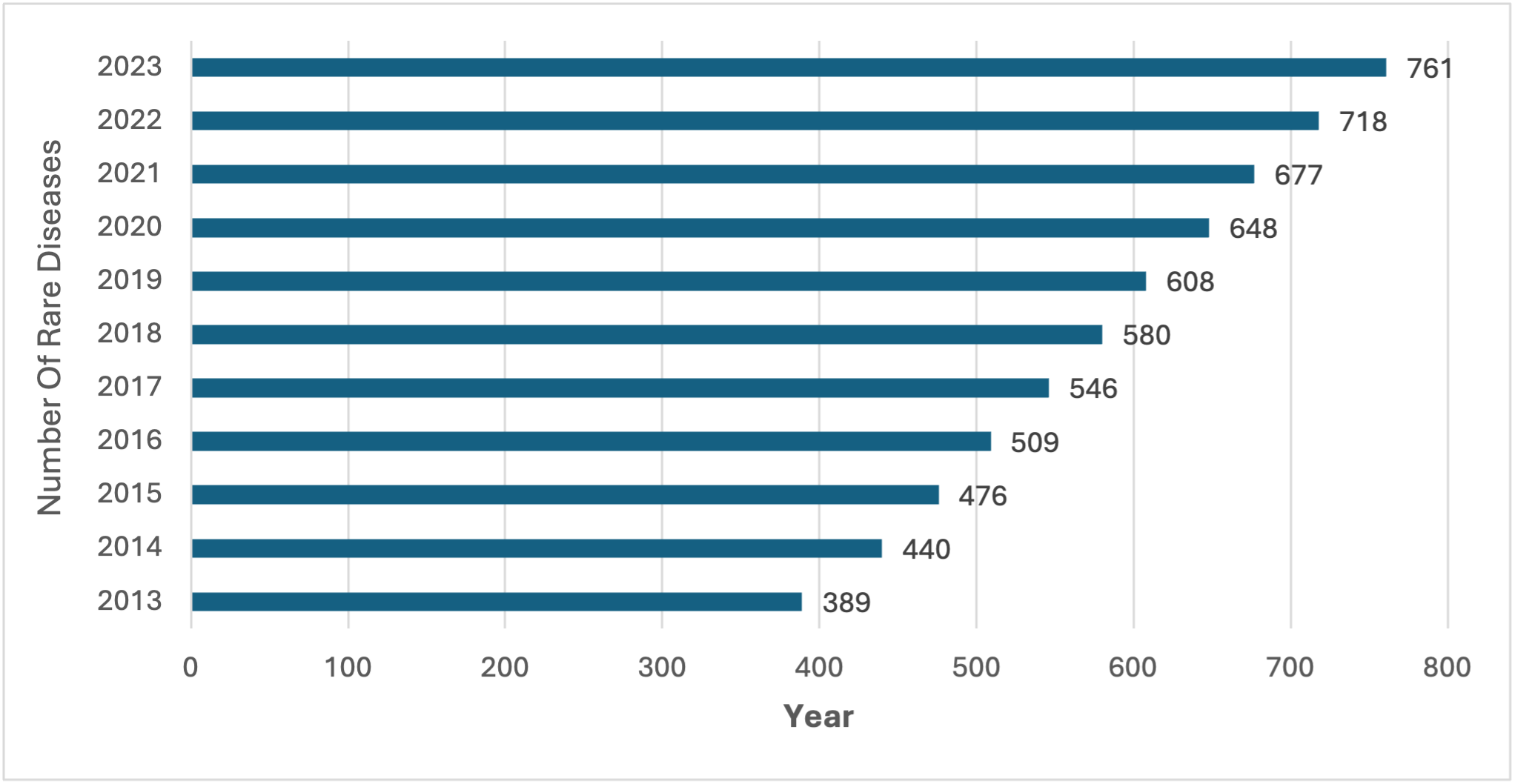

By Janelle Hart, Managing Editor, Custom Content & Andrea Charles, Head of Custom Content, Norstella (Citeline's parent company)
Pharma and biotech organizations continue to prioritize the diversification of their pipelines to innovate more in areas of high and rare unmet need. In addition to delivering life-saving treatments to patients who have had historically limited therapeutic options, addressing high and rare unmet needs can lead to faster routes to market with accelerated regulatory pathways and increased profit as a result of successful development for orphan indications.
Rare disease is one therapeutic area (TA) that has seen significant investment in recent years by large pharma companies (Figure 1), though there are many challenges associated with R&D in this space, particularly when it comes to patient recruitment and retention.

Figure 1 - Number of rare diseases being targeted by pharma; Source: Pharmaprojects®, January 2024
Given the lack of available patients with rare diseases and the complexity involved in developing drugs for medical conditions that typically do not have a basis for treatment, the rare disease R&D landscape is difficult to navigate. As a trusted strategic partner, Norstella helps guide organizations through these TA-specific challenges by supporting drug development at every stage.
The rare disease space is impacted by a lack of information and knowledge. In order to get a drug through to approval for the benefit of these patients, cross-stakeholder involvement is key throughout the drug development process from clinical trials all the way through market access. Norstella helps to optimize clinical trial design and market access strategy by providing organizations with the data, analytics, and insights they need to facilitate the speed and efficacy of drug development for rare diseases as well as understand how the industry is evolving.
With ongoing advancement in digital technologies and an industry-wide effort towards patient centricity, there are promising changes on the horizon for rare diseases. Today, on Rare Disease Day, Norstella has asked some of its TA and regulatory experts about the rare disease landscape and the impact that those changes may have on future R&D in this space.
What major trends and challenges are currently impacting the rare disease landscape?
Investment in rare diseases remains a priority. Amgen last year paid $27.8bn for Horizon Therapeutics plc, acquiring antibody assets for diseases like thyroid eye disease (Tepezza; teprotumumab) and neuromyelitis optica spectrum disorder (Uplinza; inebilizumab). Amgen generated nearly $4bn in rare disease sales in 2023. As clinical indications such as Friedreich’s ataxia, Duchenne’s muscular dystrophy, geographic atrophy and idiopathic pulmonary fibrosis continue to attract interest from big pharma companies and biotechs alike, patients who previously had few to no options stand to gain from potentially transformative therapies. In addition, with small molecule patent exclusivity terms limited to nine years prior to Medicare drug pricing negotiation in the US, industry could start favoring investments into large molecules and advanced therapeutic approaches, such as cell and gene therapy (CGT). – David Wild, Pharma/Biotech Reporter, In Vivo
Many new deals are being signed by large pharma brands who see dollars in rare diseases. For example, Biogen’s $7.3bn Reata Pharmaceuticals deal following the approval of the latter’s Friedreich’s ataxia drug Skyclarys, and Novartis’ purchase of Chinook Therapeutics, a firm that concentrates on rare kidney disease. Also notable is AstraZeneca’s Alexion arm which bought Pfizer’s early-stage gene therapy program for $1bn. – Jo Shorthouse, Acting Editor, C+D
Getting rare disease drug candidates to market has always been challenging for drugmakers, due to these products generating poor returns on investment. Unfortunately, these financial pressures remain a significant problem for the pharma industry and patients. However, a promising trend I have seen is that regulators and payers are beginning to introduce new policy measures and payment models to help companies working in this space. In the US, for instance, the Food and Drug Administration (FDA) recently began the initial phase of its ‘Operation Warp Speed for Rare Diseases’ pilot, which will draw on lessons from the COVID-19 pandemic to boost rare disease drug development. In countries where drug reimbursement is based on health technology assessment decisions, such as the UK, EU countries and Australia, efforts have been made by many national pricing and reimbursement bodies to adapt their processes to better reflect the value of rare disease therapies. – Eliza Slawther, Senior Writer, Pink Sheet
To expedite the advancement of therapies for rare diseases, the FDA has initiated the Support for Clinical Trials Advancing Rare Disease Therapeutics (START) Pilot Program. Participants in the START program will benefit from frequent guidance and interaction with FDA experts to tackle various developmental challenges associated with their assets, including aspects such as the design of clinical trials and the identification of suitable study populations. On the flipside, many in the industry have pointed to the Inflation Reduction Act (IRA) as a disincentive to orphan drug developers. Although orphan drugs are exempt from these negotiations, this provision is applicable solely to orphan drugs approved for one specific indication. The aspiration is for governmental regulators to enhance incentives for the development of rare disease drugs in the upcoming year, thereby facilitating the introduction of additional medications into the marketplace. – Jo Shorthouse, Acting Editor, C+D
How is the life sciences industry shaping up for a new era of patient recruitment and retention in rare disease?
The pharmaceutical industry is increasingly leveraging Real-World Data (RWD) and machine learning (ML) techniques to enhance rare disease patient recruitment and retention in clinical trials. Companies are using RWD to identify and engage with rare disease patients through anonymized data sets, such as electronic health records, patient registries, and wearables. ML can be applied to these unstructured data sets to find patterns and even geolocate people that meet specific rare disease criteria to enable faster patient recruitment into clinical trials. ML can also interrogate RWD to predict which patients are most likely to drop out of a clinical trial. By identifying factors such as demographic characteristics, medical history or compliance patterns associated with higher dropout rates, researchers can proactively intervene to improve patient retention through tailored interventions or support programs. – Jo Shorthouse, Acting Editor, C+D
The life sciences industry is increasingly using digital tools and new technologies to improve the clinical trial experience for patients and find eligible individuals. In the EU, the use of European Reference Networks is helping to connect patients and health care professionals virtually. These networks are highly important for rare diseases, because patients with rare conditions are often few and far between, and they could live anywhere in the world. Novel trial designs, such as decentralized trials, can also play a role in overcoming clinical trial hurdles for rare disease therapies as they make it possible for patients across the globe to join a trial. – Eliza Slawther, Senior Writer, Pink Sheet
There always has been a good relationship between patient advocacy groups and pharma, but there is now an increasing emphasis on incorporating patient perspectives and preferences into the drug development process for rare diseases. Patient advocacy groups, patient registries, and patient-reported outcome measures (PROMs) are playing an integral role in shaping clinical trial design, recruitment strategies, and regulatory decision-making, ultimately ensuring that new therapies meet the needs of those living with rare diseases. – Jo Shorthouse, Acting Editor, C+D
How are patient access and reimbursement for rare disease therapeutics evolving globally?
Many health authorities recognize the unique market access challenges faced by rare disease therapies, but efforts to alleviate these have had varied levels of success. In France, for example, the pre-marketing early-access authorization AP1 (Autorisation d’Accès Précoce) pathway enables citizens to access innovative therapies, which can include those for rare diseases, ahead of European regulatory approval. In Canada, a new rare disease strategy was introduced last year to improve access to therapeutics and address gaps in care for patients. The UK’s health technology assessment (HTA) body, the National Centre for Clinical Excellence (NICE), has also amended some of its processes to better suit rare disease therapies, however some companies have argued that these measures are still unfit for evaluating orphan drugs. Overall, these various global initiatives demonstrate a willingness from reimbursement bodies to reconsider pricing models and HTA methods, but there are still cases where products do not reach patients due to market access barriers. – Eliza Slawther, Senior Writer, Pink Sheet
Commercial access to patients with rare diseases is somewhat baked into the R&D process, as biopharma companies frequently require partnerships with patient communities and patient advocacy groups to enable recruitment and shed light on the natural history of a disease and design endpoints that matter most to patients. In terms of financial access to treatments, biopharma companies, regulators, and payers are collaborating in earnest to identify pricing strategies and reimbursement approaches for treatments that have strong evidence of improved quality of life, reduced health-care utilization and higher patient functioning. High one-time fees for CGTs, for example, present a challenge to existing payment models. Outcomes-based approaches are one approach being explored. A potential logistical barrier to clinical uptake of CGTs is the complexity of treatment administration. – David Wild, Pharma/Biotech Reporter, In Vivo
What future innovations are you most looking forward to in the rare disease space?
Therapeutic technological advances in CGTs, such as novel vectors and more accurate gene editing techniques, stand to improve treatment durability while reducing off-target effects. Additionally, emerging R&D technologies, such as digital twins and synthetic data, could allow researchers to generate virtual control arms and help fine-tune patient selection processes. – David Wild, Pharma/Biotech Reporter, In Vivo
Advances in gene therapy and gene-editing technologies, such as CRISPR-Cas9, offer tremendous potential for treating rare genetic disorders at their root cause. These therapies can offer the possibility of long-term or even permanent treatment. Last year saw Casgevy, the first CRISPR gene-editing therapy approved in the UK for sickle cell disease and beta thalassaemia. RNA-based therapeutics, including mRNA and RNA interference (RNAi) therapies, are also emerging as powerful tools for targeting a wide range of rare diseases. These therapies can open up new avenues for treatment in previously challenging-to-address conditions. Finally, precision medicine, which involves tailoring treatments to individuals based on their unique genetic makeup, environment, and lifestyle factors, is increasingly being applied to rare diseases. By identifying specific genetic mutations or biomarkers associated with rare diseases, researchers can develop more targeted and effective therapies, leading to improved outcomes for patients. – Jo Shorthouse, Acting Editor, C+D
Genomic sequencing tools are increasingly beneficial to pharmaceutical companies developing drugs for rare diseases during clinical trials, as these products can help identify patient subgroups or certain biomarkers that could affect the efficacy of a product. Artificial intelligence could also play a role in analyzing genomic sequences to identify potential gene alterations involved in rare diseases. I think this is a space where medtech and pharma could really work together to find new solutions for patients. – Eliza Slawther, Senior Writer, Pink Sheet
How is Norstella smoothing the path for life-saving treatment delivery to patients with rare diseases?
Data curated and analyzed by Norstella can help companies optimize their investment decisions, for example by avoiding indications that are becoming saturated with competition. In Vivo provides insights into company-specific strategies and innovations, ranging from novel patient recruitment practices to unique clinical development processes, as well as to industry-wide investment and therapeutic trends. In Vivo insights are gleaned from executive and expert interviews as well as from in-house data and are presented in both written and graphic format. – David Wild, Pharma/Biotech Reporter, In Vivo
Norstella’s insights publications, which include Pink Sheet, provide rare disease drugmakers, investors and other relevant industry professionals with timely rare disease market updates and analysis. This coverage highlights new initiatives and developments relevant to rare diseases that companies can benefit from, such as regulatory pilot schemes or funding opportunities. This means that companies have the best chances of addressing any challenges they are facing - be it in the R&D, regulatory or post-market stage. Our articles also include exclusive interviews with important players in the rare disease space, including company executives and key opinion leaders in policy and regulation. Norstella’s other products offer solutions to common problems faced by rare disease companies in the form of data analytics, consulting and market research. – Eliza Slawther, Senior Writer, Pink Sheet
We at Norstella are looking to smooth the path from pipeline to patient by focusing our efforts to help these rare disease companies make the best decisions possible to speed up development. Whether this is through assisting in patient recruitment, providing data to support commercial development or contributing expert analyst analysis for reimbursement decisions, we are dedicated to doing our part for rare disease patients. – Sara LaFever, Executive Director, Product Services, Citeline
Enabling patients to have access to treatments from which they could benefit requires so much more than just approval; it also involves its own set of requirements for each region. Commercial access also necessitates coordinated commercial operations and an understanding of the current and future drug landscape. From trusted names like Trialtrove, Sitetrove, Datamonitor, and Dedham group, Norstella enables products to get from concept all the way through to a patient’s hands. – Pamela Spicer, Therapy Area Director, CNS I&I, Citeline

Sara LaFever
Executive Director, Product Services, Citeline

Jo Shorthouse
Acting Editor, C+D

Eliza Slawther
Senior Writer, Pink Sheet

Pamela Spicer
Therapy Area Director, CNS I&I, Citeline

David Wild
Pharma/Biotech Reporter, In Vivo